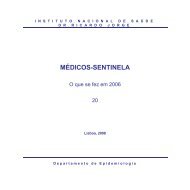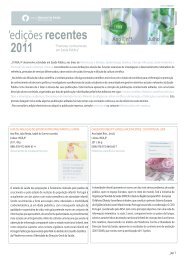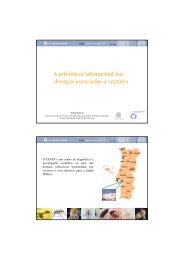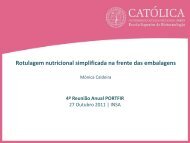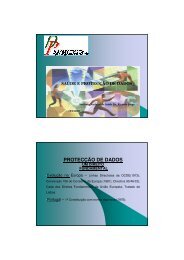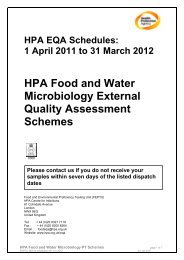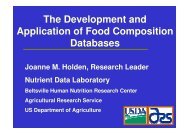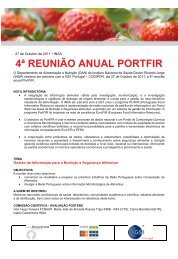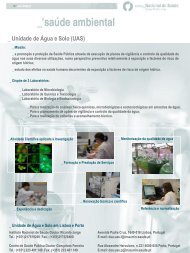European Society of Mycobacteriology - Instituto Nacional de Saúde ...
European Society of Mycobacteriology - Instituto Nacional de Saúde ...
European Society of Mycobacteriology - Instituto Nacional de Saúde ...
Create successful ePaper yourself
Turn your PDF publications into a flip-book with our unique Google optimized e-Paper software.
QUANTIFERON-TB GOLD ASSAY (QFT) AND TUBERCULINE SKIN TEST (TST)<br />
CLINICAL PERFORMANCE FOR THE DIAGNOSIS OF ACTIVE TUBERCULOSIS<br />
PP-70<br />
Karabela Simona, Papaventsis Dimitrios, Nikolaou Stavroula, Konstantinidou Efthimia, Sainti Asimina, Ioannidis Panayotis,<br />
Kanavaki S<strong>of</strong>ia<br />
National Reference Center for Mycobacteria, “Sotiria” Hospital, Athens, Greece<br />
Objective<br />
The purpose <strong>of</strong> this study was to evaluate and compare Quantiferon-TB Gold In-Tube (QFT, Cellestis, Australia) and the<br />
tuberculine skin test (TST) in patients with active TB, with and without previous BCG vaccination.<br />
Methods<br />
Patients with symptoms compatible with active TB were inclu<strong>de</strong>d. The TST was performed according to the Mantoux<br />
method and the QFT assay according to the manufacturer’s instructions. The cut-<strong>of</strong>f value for a positive result was ≥0.35<br />
IU/ml interferon-gamma (IFN-γ). Sensitivity, specificity, positive and negative predictive values were calculated and compared<br />
for QFT and TST tests. Agreement between QFT and TST was assessed by the kappa (κ) coefficient.<br />
Results<br />
A total <strong>of</strong> 296 patients were enrolled in the study. One hundred eighty-nine had a record regarding BCG vaccination.<br />
Forty-four (23%) <strong>of</strong> the 189 patients had been vaccinated. In total, the sensitivity and specificity <strong>of</strong> QFT, excluding those<br />
with in<strong>de</strong>terminate results, was 79% (52/66; 95% CI: 66-88%) and 66% (153/167; 95% CI: 58-73%), respectively. The sensitivity<br />
and specificity <strong>of</strong> TST was 72% (46/64; 95% CI: 58-83%) and 67% (156/232; 95% CI: 59-74%), respectively. The overall<br />
concordance between the QFT and TST tests was 70.2%, with a kappa value <strong>of</strong> 0.46 (95% CI: 0.289-0.524). In the BCGvaccinated<br />
subgroup, agreement between the two assays was 66%, with a kappa value <strong>of</strong> 0.350 (95% CI: 0.103-0.597). The<br />
difference with the non-vaccinated subgroup (κ=0.463; 95% CI: 0.303-0.623) was consi<strong>de</strong>red to be not quite statistically<br />
significant (p>0.05). Initial TST positive screening followed by a QFT positive result was found to have greater sensitivity<br />
and specificity in the non-vaccinated [sensitivity=79% (95% CI: 59-92%); specificity=81% (95% CI: 71-88%)] compared to<br />
the BCC-vaccinated subgroup [sensitivity=67% (95% CI: 30-92%); specificity=75% (95% CI: 57-89%)].<br />
Conclusion<br />
This study confirmed previous reports that QFT assay has higher sensitivity for <strong>de</strong>tecting active TB compared to TST.<br />
An overall mo<strong>de</strong>rate agreement between TST and QFT was found. The difference in agreement between non-vaccinated<br />
and BCG-vaccinated subgroups could be attributed to TST influence by vaccination. In patients with active TB and no<br />
BCG-vaccination history, TST screening followed by subsequent QFT testing proved to present the highest sensitivity<br />
and specificity for TB diagnosis. Larger prospective studies are nee<strong>de</strong>d to confirm our results.<br />
142 ESM 2009



